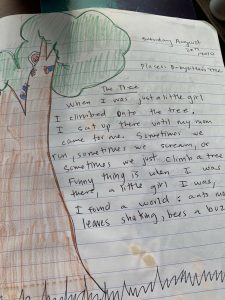Writing and speaking matter. Art, memes, sketches, and photos all serve as important outlets. In the age of Youtubers emerging with more followers than I can count, social-video expression matters. It’s all a part of something innate within us, and skills we want students to develop to be successful and happy adults. In our schools, the worst thing we can model for children is to place our thoughts, experiences, and ideas passively on a cliff’s edge. They will eventually blow away or crash below by the sheer weight of neglect. The art of teaching writing and thought emergence for most educators begins with looking at Texas Essential Knowledge and Skills, and aligning with school goals, milestones, and assessments. What if we stopped and saw this as the art of teaching self-expression?
As an educator, I planned out the scope and sequence and writing process for other teachers to use. I quickly realized telling my students they needed to be expressive wasn’t enough to make it happen. I also realized how uncomfortable the teachers around me were with the weight of being the role model for writing. This led me to questions the insecurities that students hold with self- expression as well. Ask yourself, “how comfortable am I expressing myself”?
For leaders in education, you have the opportunity to show that you have a stage and choose how to express yourself. When was the last time you wrote something you were proud of? Spoke aloud your message and felt empowered with your point, your delivery? When was the last time as an adult that you took an idea, thought, or experience and creatively housed it in a picture, a meme, a sketch, or painting? Or, when did you encourage your teachers and colleagues to express themselves? Kids are watching, learning, and taking in the value of your expression.
Eleven years ago, I sat down with second graders and told them I was going to show them something so valuable, so special, and unique, that only I had it, a treasure. I shared with them my writer’s notebook that I had declared to be mine alone with the jewels and elusive tree on the outside. I suggested we stop and give them the evening to make their notebook, their own. The next day, the kids could hardly wait for writing time. We sat in a circle and they shared their marvelous creations. Some had already started writing inside because they were so excited. My favorite was the composition book completely covered in hot glued Legos. What became of those was the powerful part of this story. I showed them how to write. Sometimes it was ideas, sometimes it was a funny thought, or a quick sketch to remember the key of the experience. From those launching pads I could model the writing process, and the Texas expectations that come from the important need to build, edit, and analyze our work. The best part of the story is that my students hated when writing time was over. I had a group of rowdy young gentlemen who “AGGHED!” when I said it was recess time. It wasn’t because of me; it was because they were expressing themselves and wanted to finish. I have Lucy Calkins out of The Teacher’s College in Columbia to thank for pivoting to teaching writing with modeling.
There are so many opportunities within the confines of the school day to model self-expression. School changes and policies could be modeled in a speech, celebrations could be modeled creatively in speeches, poems, and videos. It is why principals who challenge the traditional method of declaring a snow day with one sentence, go viral for creating a video to express the statement in a creative way. NPR has posts teaching students how to start a student podcast, and a student podcast challenge to showcase their work. In this digital intertwining we find ourselves in, why not look to starting a school newspaper online and building community with students while allowing them a platform to express their lives, and see their teachers and administrators add to that community? I am not advocating for a shift that means a video or laborious undertaking for everything we have to communicate to students. I am suggesting that there is a powerful platform and so much opportunity to spark students be self-expressive. Furthermore, it illuminates the path our students are on physically, emotionally, and mentally.
I remember being vulnerable with my students in sharing a writing page of a recollection I had. When I was young, I would wait for my mom to pick me up, in my babysitter’s tree. It felt safe waiting for her there. The yelling in the house scared me, and tree made me feel safe. I wrote a quick poem about it and shared it. My students started pouring experiences, both high and low into their notebooks, without me asking. Some asked to show me them, some kept them for later shares, and some, simply found a place they could express themselves in. It’s the difference between us teaching speech writing with methods, and index cards, and us teaching speech writing that includes watching Martin Luther King Jr.’s I have a Dream, hearing Nelson Mandela speak, hearing Winston Churchill, Maya Angelou, and more. Have you ever listened to Maya Angelo read aloud “On the Pulse of the Morning,” without feeling chills? It is the difference that includes modeling the power of self- expression, and then supporting them with the skill part.

We can find ourselves in the proverbial mud there too, wondering who didn’t get to speak? It is a good place for us to challenge ourselves and allow students to ask questions. Why did they feel they couldn’t speak? Why do we feel we cannot express ourselves in various moments in our lives? How does that alone make us, and others feel? We can also find that historically oppressed students have a platform emerge. English language learners, minority students, and students with disabilities, can find that they have an outlet and the support as they create.
Before we show students that everything must be communicated in one or two methods, or solely for meeting a standard, I implore us to look at the power of being in education and the creativity we can model. Think of all the written word, poems, photographs, videos, and art inside of you, and locked away inside students. First, express yourself, your students will follow.

Kira Hawkins has been involved in education for over a decade. She has taught grades K-5 in the state of Texas before venturing online to teach students in Singapore, China, Japan, and across the United States. She spent time in Zambia, working with students of different ages as well. You can find her connecting with districts in Texas around special education services now. You can also find her with a stack of “next up” books, seeds to plant in her ever growing garden, and learning from her small herd of goats.


